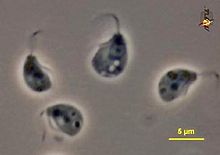| Loukozoa | |
|---|---|

| |
| Malawimonasms | |
|
Scientific classification
| |
| Domain: | Eukaryota |
| Superphylum: | Eozoa |
| Phylum: |
Loukozoa Cavalier-Smith, 1999 [1] |
| Subgroups | |
Loukozoa (+ Ancyromonads) (From Greek loukos: groove [1]) is a proposed taxon used in some classifications of eukaryotes, consisting of the Metamonada and Malawimonadea. [2] Ancyromonads are closely related to this group, as sister of the entire group, or as sister of the Metamonada. Amorphea may have emerged in this grouping, specifically as sister of the Malawimonads. [3]
Originally, Loukozoa included Anaeromonadea and Jakobea. [1] In 2013, it consisted of three subphyla: Eolouka ( Tsukubea and Jakobea), Metamonada and Neolouka ( Malawimonas). [4] Cavalier-Smith has recently removed Eolouka from Loukozoa, placing it instead in Discoba. [2] [5]
With the root of the Eukaryota likely close to or in Loukozoa or Discoba, these groupings are studied to give unique information on the first Eukaryotes. [6]
References
- ^ a b c Cavalier-Smith, T. (1999). "Principles of protein and lipid targeting in secondary symbiogenesis: Euglenoid, dinoflagellate, and sporozoan plastid origins and the eukaryote family tree". The Journal of Eukaryotic Microbiology. 46 (4): 347–366. doi: 10.1111/j.1550-7408.1999.tb04614.x. PMID 18092388. S2CID 22759799.
- ^ a b Cavalier-Smith, Thomas (2017). "Euglenoid pellicle morphogenesis and evolution in light of comparative ultrastructure and trypanosomatid biology: semi-conservative microtubule/strip duplication, strip shaping and transformation". European Journal of Protistology. 61 (Pt A): 137–179. doi: 10.1016/j.ejop.2017.09.002. PMID 29073503.
- ^ Lax, Gordon; Eglit, Yana; Eme, Laura; Bertrand, Erin M.; Roger, Andrew J.; Simpson, Alastair G. B. (2018-11-14). "Hemimastigophora is a novel supra-kingdom-level lineage of eukaryotes". Nature. 564 (7736): 410–414. Bibcode: 2018Natur.564..410L. doi: 10.1038/s41586-018-0708-8. ISSN 0028-0836. PMID 30429611. S2CID 205570993.
- ^ Cavalier-Smith, Thomas (2013). "Early evolution of eukaryote feeding modes, cell structural diversity, and classification of the protozoan phyla Loukozoa, Sulcozoa, and Choanozoa". European Journal of Protistology. 49 (2): 115–178. doi: 10.1016/j.ejop.2012.06.001. PMID 23085100.
- ^ Cavalier-Smith, Thomas (2018-01-01). "Kingdom Chromista and its eight phyla: a new synthesis emphasising periplastid protein targeting, cytoskeletal and periplastid evolution, and ancient divergences". Protoplasma. 255 (1): 297–357. doi: 10.1007/s00709-017-1147-3. ISSN 0033-183X. PMC 5756292. PMID 28875267.
- ^ Brown, Matthew W; Heiss, Aaron A; Kamikawa, Ryoma; Inagaki, Yuji; Yabuki, Akinori; Tice, Alexander K; Shiratori, Takashi; Ishida, Ken-Ichiro; Hashimoto, Tetsuo (2018-01-19). "Phylogenomics Places Orphan Protistan Lineages in a Novel Eukaryotic Super-Group". Genome Biology and Evolution. 10 (2): 427–433. doi: 10.1093/gbe/evy014. ISSN 1759-6653. PMC 5793813. PMID 29360967.
| Loukozoa | |
|---|---|

| |
| Malawimonasms | |
|
Scientific classification
| |
| Domain: | Eukaryota |
| Superphylum: | Eozoa |
| Phylum: |
Loukozoa Cavalier-Smith, 1999 [1] |
| Subgroups | |
Loukozoa (+ Ancyromonads) (From Greek loukos: groove [1]) is a proposed taxon used in some classifications of eukaryotes, consisting of the Metamonada and Malawimonadea. [2] Ancyromonads are closely related to this group, as sister of the entire group, or as sister of the Metamonada. Amorphea may have emerged in this grouping, specifically as sister of the Malawimonads. [3]
Originally, Loukozoa included Anaeromonadea and Jakobea. [1] In 2013, it consisted of three subphyla: Eolouka ( Tsukubea and Jakobea), Metamonada and Neolouka ( Malawimonas). [4] Cavalier-Smith has recently removed Eolouka from Loukozoa, placing it instead in Discoba. [2] [5]
With the root of the Eukaryota likely close to or in Loukozoa or Discoba, these groupings are studied to give unique information on the first Eukaryotes. [6]
References
- ^ a b c Cavalier-Smith, T. (1999). "Principles of protein and lipid targeting in secondary symbiogenesis: Euglenoid, dinoflagellate, and sporozoan plastid origins and the eukaryote family tree". The Journal of Eukaryotic Microbiology. 46 (4): 347–366. doi: 10.1111/j.1550-7408.1999.tb04614.x. PMID 18092388. S2CID 22759799.
- ^ a b Cavalier-Smith, Thomas (2017). "Euglenoid pellicle morphogenesis and evolution in light of comparative ultrastructure and trypanosomatid biology: semi-conservative microtubule/strip duplication, strip shaping and transformation". European Journal of Protistology. 61 (Pt A): 137–179. doi: 10.1016/j.ejop.2017.09.002. PMID 29073503.
- ^ Lax, Gordon; Eglit, Yana; Eme, Laura; Bertrand, Erin M.; Roger, Andrew J.; Simpson, Alastair G. B. (2018-11-14). "Hemimastigophora is a novel supra-kingdom-level lineage of eukaryotes". Nature. 564 (7736): 410–414. Bibcode: 2018Natur.564..410L. doi: 10.1038/s41586-018-0708-8. ISSN 0028-0836. PMID 30429611. S2CID 205570993.
- ^ Cavalier-Smith, Thomas (2013). "Early evolution of eukaryote feeding modes, cell structural diversity, and classification of the protozoan phyla Loukozoa, Sulcozoa, and Choanozoa". European Journal of Protistology. 49 (2): 115–178. doi: 10.1016/j.ejop.2012.06.001. PMID 23085100.
- ^ Cavalier-Smith, Thomas (2018-01-01). "Kingdom Chromista and its eight phyla: a new synthesis emphasising periplastid protein targeting, cytoskeletal and periplastid evolution, and ancient divergences". Protoplasma. 255 (1): 297–357. doi: 10.1007/s00709-017-1147-3. ISSN 0033-183X. PMC 5756292. PMID 28875267.
- ^ Brown, Matthew W; Heiss, Aaron A; Kamikawa, Ryoma; Inagaki, Yuji; Yabuki, Akinori; Tice, Alexander K; Shiratori, Takashi; Ishida, Ken-Ichiro; Hashimoto, Tetsuo (2018-01-19). "Phylogenomics Places Orphan Protistan Lineages in a Novel Eukaryotic Super-Group". Genome Biology and Evolution. 10 (2): 427–433. doi: 10.1093/gbe/evy014. ISSN 1759-6653. PMC 5793813. PMID 29360967.